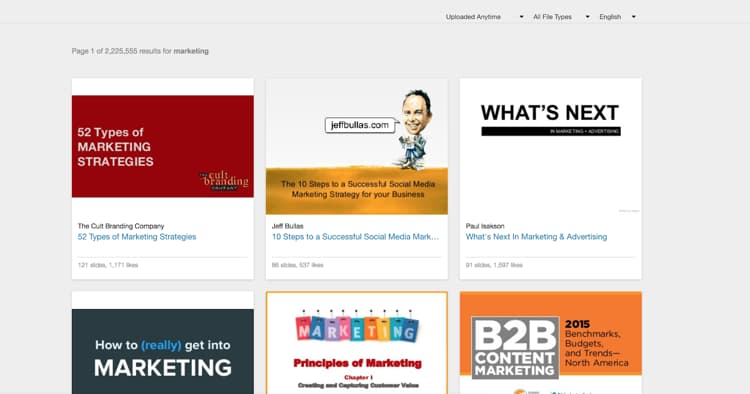Slideshare as a powerful source of traffic
1. Slideshare as a powerful source of traffic

For those of you that may be unaware, Slideshare is a presentation-sharing platform (now owned by LinkedIn) that also happens to be one hell of a powerful traffic source.
When it comes to multiplying and repurposing your content, Slideshare is an easy way to lengthen the lifecycle of your blog posts, and to increase the exposure you’re able to get for an individual article—all you need to do is use a presentation maker tool to whip up a more visually appealing slideshow-style representation of your content, and publish to Slideshare.
While this tactic might not be as effective for bloggers whose audience doesn’t spend a lot of time on LinkedIn, this same principle of turning your blog post into a simple powerpoint presentation is still applicable to any blogger, no matter what niche you’re in.
Sharing your slide deck on social networks like Pinterest, Instagram as an IG story, or on Twitter can be just as effective as a tool to grow your blog—if your audience is active on those social networks.
2. Join active communities in your blogging niche

No blog exists in a vacuum, if you’ve picked a niche to blog about with some popularity—then you’re really in luck.
While we might have romantic ideas of going it alone learning how to grow your blog without ever needing help from others, the reality is that there are literally thousands—if not millions—of blogging communities out there filled with other bloggers who are more than happy to share your content with their own audience.
Some great blogging communities to join include GrowthHackers, Product Hunt, Triberr, BlogEngage and DoSplash.

Depending on your niche, some communities will work better than others, but rest assured that in any one of those blogging communities you’ll find 3. Make sure your blog content is readable

If you’ve ever seen Disney’s Aladdin you’ll probably be familiar with the phrase “a diamond in the rough.”
There’s certainly a thrill in the romantic notion of putting in the effort to look past the surface and finding diamond beneath. But, in today’s world where the average attention span for a human is, quite literally, shorter than a goldfish, you need to be shining from the get-go if you want to grow your blog.
At the end of the day, it doesn’t matter how valuable the information in your blog is, if no one can even be bothered to easily read it in the first place.
Take a step back from your blog and try putting yourself in the discerning shoes of your reader. Objectively, ask yourself questions such as whether or not your blog’s design is too cluttered, if you could use some images or videos to help break up the text, or if the way you’re writing might come across as overly complicated.
4 Monitor social media for mentions of your blog

Something that many bloggers overlook when they’re just starting out learning how to grow a blog, is the “social” aspect of social media.
Social media is more than just a place for you to promote your blog content—it’s also a space where you can interact and communicate with your readers in an informal and personal way. And ultimately, the strength of your relationships with your readers will often dictate how likely they are to invite new readers over to your content.
The trick to playing an active part in that conversation, is social media monitoring.
Make use of tools like Mention and Buffer Reply to get notified whenever someone mentions your brand (or name of your blog) online. You can use social media monitoring to do anything from sending a personal thank you message any time someone shares your content unasked, to gaining insight into what your readers are like, or even as a way to resolve customer service issues before they can escalate—thus proving a very useful way to grow a blog over time.
5. Build a community on Twitter

With over 126 million daily active users and 5787 tweets being posted every second, Twitter is undoubtedly one of (if not the) best social media platforms for engaging with your audience and growing your blog readership.
You can engage with your readers on Twitter by regularly responding to any tweets that mention you and your blog, and also by starting your own public conversations with your readers.
For example, starting a hashtag chat can be a great way to center a conversation around a specific theme or topic with your readers, while also having anyone who participates in that discussion feel like they’re a part of your community—as well as having the option to invite others into the chat.
Comments
Post a Comment